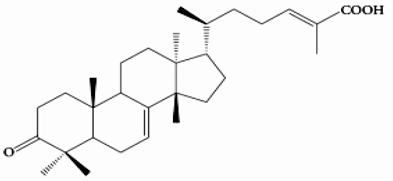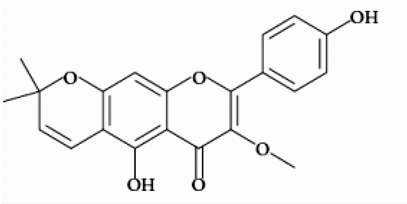Abstract
Polyphenolic and Terpenoids are potent natural antiparasitic compounds. This study aimed to identify new drug against Leishmania parasites, leishmaniasis’s causal agent. A new in silico analysis was accomplished using molecular docking, with the Autodock vina program, to find the binding affinity of two important phytochemical compounds, Masticadienonic acid and the 3-Methoxycarpachromene, towards the trypanothione reductase as target drugs, responsible for the defense mechanism against oxidative stress and virulence of these parasites. There were exciting and new positive results: the molecular docking results show as elective binding profile for ligands inside the active site of this crucial enzyme. The ADMET study suggests that the 3-Methoxycarpachromene has the highest probability of human intestinal absorption. Through this work, 3-Methoxycarpachromene and Masticadienonic acid are shown to be potentially significant in drug discovery, especially in treating leishmaniasis. Hence, drug development should be completed with promising results.
1. Introduction
Leishmaniasis is a non-contagious infectious vector-borne disease [1] that is still responsible for extensive morbidity and mortality in the world [2]. A paramount public health concern, it is endemic in 98 countries. Approximately 2 million new cases are registered annually, with about 50,000 deaths each year [3]. Two epidemiological forms, cutaneous and visceral leishmaniasis, are diffuse in Algeria, which has the second-highest prevalence of cutaneous leishmaniasis ranks, after Afghanistan [4].
Currently, no effective vaccine is available for leishmaniasis treatment [5]. Chemotherapy is the fore most approach to treat these infections [6]. Current drug treatments for all forms of leishmaniasis have a severe impact on humans, including renal failure, hepatotoxicity, leucopenia, neurotoxicity, cardiotoxicity [7,8,9], etc. However, lack of potential alternatives has forced patients to be dependent on these chemotherapeutic drugs [10]. Several scientific reports declared a therapeutic failure linked to the emergence of drug-resistant strains [11,12,13,14].
In this context, regarding these multiple factors, it is necessary to search for a new alternative drug to treat leishmaniasis. More attention has been paid to the natural herbal compounds to avoid the inconveniences of chemotherapy [10]. Molecular docking has become a significant tool for high-throughput virtual screens and drug discovery [9]. Up to 24 Leishmania enzymes (52 distinct protein structures from the Protein Data Bank (PDB)) have been exploited as potential enzyme drug targets, utilizing the Molegro Virtual Docking software [15]. Table 1 presents the target enzymes for Leishmania infantum from the literature. The trypanothione reductase, one of the most important targets for leishmania treatment, was identified as a valid drug target for trypanosomatids in 1985 [16] because the enzyme demonstrated to be essential for the survival of these parasites by protecting them from oxidative stress [17,18,19].

Table 1.
Targets enzymes for L. infantum from literature.
Pistacia atlantica. Desf (P. atlantica) is the famous taxonof the Pistacia genus belonging to the family Anacardiaceae that grows in the Middle Eastern and Mediterranean regions. Traditionally, itsplant parts were employed for therapeutic purposes due to their healing potential [24], used for ailments such as stomach aches, indigestion, throat infections, and peptic ulcers and as an insect repellent, a chest diseases expectorant, and an anti-asthma product [25]. Previous researchers have described various biological activities for different P. atlantica extracts, i.e.,antimicrobial, antifungal, antiviral, antiplasmodial, and antileishmanial [26]. Different parts of P. atlantica have been investigated for various phytochemical studies. Most of the papers are devoted to terpenoids. For example, they marked the presence of α-pinene, β-pinene, limonene, terpinolene, camphene, terpinen-4-ol, bornylacetate, sabinene, p-mentha-1 (7), 8 diene, masticadienonic acid, masticadienolic acid, and morolic acid in the different plant parts [27,28]. Great importance has also been attributed to the phenolic compounds present in the plant parts, i.e., gallica cid, quercetin-3-glucoside, catechin, epicatechin, naringenin, apigenin, caffeic acid, ferulic acid, and 3-methoxycarpachromeneare [27,29]. The in silico analysis literature shows an important number of natural antiparasitic compounds, such as polyphenolic and terpenoids [15,30,31]. The present study aimed to identify new selective inhibitors of trypanothione reductase (TR) using a computational investigation. We have selected masticadienonic acid and 3-methoxycarpachromene (Table 2) as ligands from the above-cited terpenoids and phenolic compounds because the inhibition effect to this enzyme has not yet been studied, and there is no docking of these ligands with thischosen target.In particular, previous studies have shown the antiparasitic activity of the masticadienoic acid that could be used to develop new prototypes for pharmaceutical drug design studies to treat leishmaniasis and Chagas disease [32]. In addition, the masticadienoic acid has a strong antimicrobial activity against strains of H. pylori and Gram-negative bacteria [33]. In the same context, the 3-methoxycarpachromene has shown antiprotozoal activity and anantiplasmodial effect against Plasmodium falciparum [34].

Table 2.
The selected ligands of the chemical ingredients of P. atlantica cited in the literature.
2. Results and Discussion
2.1. Molecular Docking
Few drugs for leishmaniasis treatment are available, and generally, they have strongly associated side effects and can introduce parasite resistance. Therefore, there is an urgent necessity to identify new compounds with broad-spectrum leishmanicidal activities that are less toxic and more cost-effective. Natural sources can be an attractive alternative for the screening of new drugs with medicinal potential.
These novel natural materials can be screened through different strategies, such as the in silico approaches used in the early stages of drug discovery. Such approaches, in combination with in vitro and in vivo biological tests, can significantly shorten the time and reduce the cost of drug discovery and enhance safety assessment [35].
The docking studies are employed at various steps in drug discovery, particularly to predict the docked structure of the ligand-receptor complex and to classify ligand molecules on the criterion of their binding energy. Docking procedures help to elucidate the most energetically favorable binding position of a ligand to its receptor [36].
The objective of our present docking study is to check new drugs by elucidating the interaction mode of the above-selected ligands with the catalytic site of trypanothione reductase.
These simulations predicate that the binding energies were calculated for each cluster and negative values were obtained in the two cases: −8.4 kcal/mol for 3-Methoxycarpachromene and −6.2 kcal/mol for Masticadienonic acid, which translated into theoretical Ki values of 0.038 and 0.09 M, respectively (Table 3). These low-binding free energies confirm the stability of the studied complexes. 3-Methoxycarpachromene interacts with three hydrogen bonds (Glu466: 1.85 Å; His461:2.58 Å; Asn340: 2.44 Å) and different hydrophobic types of interactions (Π-Alkyl, Π-sigma, Π-cation, and Alkyl-alkyl with Asn340, Arg472, Cys469, Thr457, Ile339, and Ala343). This ligand is better than Masticadienonic acid in both binding energy and number of interactions in particular to two catalytic residues(His 461, Glu466),from the more active residues in the catalysis, namely His 461’, Glu466’,Cys57, Cys52, and Glu467’Glu466 His461 (Figure 1 and Figure 2), but both molecules link up in the cavity.

Table 3.
The results of interactions between compounds and trypanothione reductase.
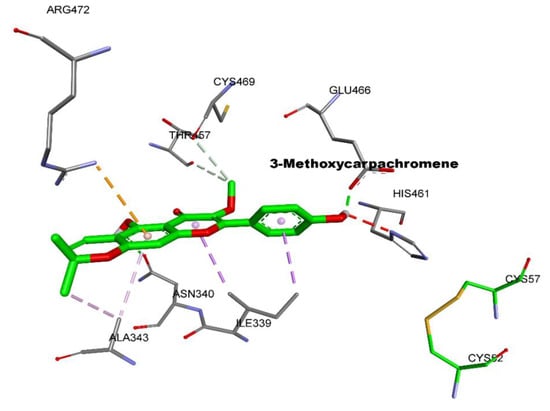
Figure 1.
Best pose of docking for 3-Methoxycarpachromene in the catalytic site of trypanothione reductase.
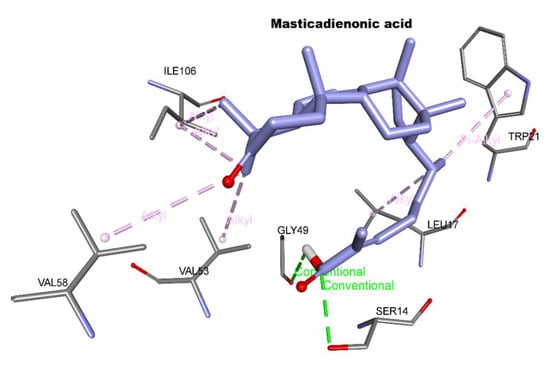
Figure 2.
Best pose of docking for Masticadienonic acid in the catalytic site of trypanothione reductase.
It should be noted that TRis a key enzyme in the redox trypanosomatid metabolism when its structure is identical for all the characterized species of Trypanosomatidae (67% similarity of primary sequence from Trypanosomatidae, 82% identity between Leishmania spp., and >80% among Trypanosoma spp.) [37], such as those of T. cruzi, T. brucei, and Crithidia fasciculata [38,39,40]. TR is a homodimer with double symmetry in which every subunit is constituted by three domains, the interface domain (residues 361–488), the NADPH-binding domain (residues 161–288), and the FAD-binding domain (residues 1–160 and 289–360). The binding site for trypanothione as substrate resides in a large cavity at the interface between both subunits, which is formed by the residues of the FAD-binding domain of one monomer and those of the interface of the second domain. The catalysis mechanism of trypanothione reduction implies that the transfer of two electrons is from NADPH via FAD to the Cys52-Cys57 disulfide bridge. The substrate subsequently binds to the enzyme and Cys52, deprotonated by the His461’-Glu466’ pair, and performs a nucleophilic attack on the trypanothione disulfide bridge that results in the formation of a mixed disulfide. Finally, an attack of Cys57 on Cys52 promotes the release of the reduced substrate [41]. Considering that the residues forming the binding sites for the substrates reach 100% similarity, the ligand-binding mode is the same for all TRs characterized so far [37,42]. Thus, this result proves to be important in the treatment of all diseases linked to Trypanosomatidae species. Those parasites lacking this enzyme are avirulent and highly sensitive towards reactive oxygen species [43]. Moreover, reducing this enzyme activity to 50% or less of normal ranges decreased the ability of several Leishmania spp. to proliferate within activated macrophages [44,45,46]. This fact makes TR an attractive target for the development of new potential drugs. An additional property that makes TR a potential therapeutic target for antiparasitic drugs is its significant structural divergence from glutathione reductase, the enzyme with the equivalent functionality in humans [47,48,49].
2.2. ADMET Study
The design of a drug compound or molecule takes into account several crucial factors. These include the pharmacokinetics and toxicological properties: absorption, distribution, metabolism, excretion, and toxicity (ADMET) and the final bioactivity of the compounds. Thus, the process of optimizing drug development is multidimensional. In the end, a balance must be attained in view of obtaining the best in terms of both the activity and properties of the compound [50].
Thus, ADMET computational evaluations were conducted to compare the selected ligands with miltefosine, the only currently available oral treatment for leishmaniasis. The result generated from the Lipinski and ADMET filtering analyses are presented in Table 4. The two ligands fulfilled the requirement for Lipinski analysis of the rule offive with corresponding favorable predicted ADMET parameters. The predicted physiochemical properties for bioavailability of the lead compounds were further represented in Figure 3. The ADME/tox and pharmacokinetic properties from the filtering analyses suggested that the 3-methoxycarpachromene hasa high probability of human intestinal absorption and subcellular distribution, while the masticadienonic acid and the miltefosine presented low intestinal absorption.

Table 4.
ADMET profiling enlisting absorption-, metabolism-, and toxicity-related drug-like parameters of the two selected ligands.
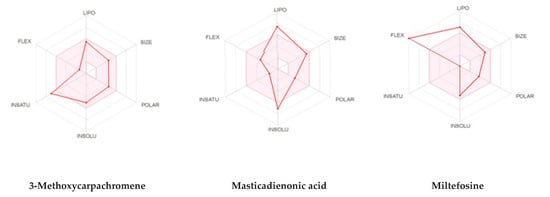
Figure 3.
Summary of the pharmacokinetic properties of the studied complexes.
3. Materials and Methods
3.1. Molecular Docking
We achieved molecular docking using the TR enzyme, one of the most important targets for leishmania treatment (Table 1); after detailed screening in the Protein Data Bank (PDB), we found many PDB files of this enzyme.We chose the enzyme with PDB ID: 5EBK because it is complexed with inhibitors; in addition, the inhibition mechanism is well described in the work of Saccoliti et al., 2017 [51,52]. From the above-cited terpenoids and phenolic compounds, we selected the following ligands: Masticadienonic acid as a triterpenoid [33] and 3-Methoxycarpachromene a tetracyclic flavone, which are extractible by the same organic solvent [34] (Table 2). The ligands were obtained from the PubChem database [53] and assembled with Discovery Studio visualizer v4.0. We have prepared the protein by removing all unnecessary water molecules, heteroatoms, ligands, and co-crystallized solvents. Polar hydrogens and partial charges were added to the structure using Autodock tools (ADT) (version 1.5.4). We performed the molecular docking (blind docking) using the AutoDock Vina program [52] in an eight-CPU station. The software uses rectangular boxes for the binding site; the center of the box was set and displayed using ADT. The enzyme’s grid box was set with 1 Å separated grid points positioned in the middle of the active site for the studied protein.
Regarding the flexibility of the side chain during this specific docking, flexible torsions in the ligands were assigned, and the acyclic dihedral angles were allowed to rotate freely [53]. The default settings were used, except that the number of output conformations was set to one. The number of docking runs was set at 10 runs. The number of solutions obtained is equal to 10 conformations for each ligand and enzyme. All these solutions are well handled. The “random seed” is random. The preferred conformations were those of lower binding energy within the active site. Finally, the generated docking results were directly loaded into Discovery Studio Visualizer, v 4.0.
3.2. ADMET Study
To evaluate the two studied compounds’ drug-likeness prediction, they were subjected to a Lipinski filter in which an orally bio-active drug is expected to not violate more than one of the criteria for drug-likeness, namely cLogP, hydrogen donor and acceptor molecular mass, and molar refractive index [54]. The predicted Absorption Distribution Metabolism, Excretion and Toxicity (ADMET) values were analyzed using the Swiss ADME server (http://www.swissadme.ch/index.php) [55], which has been reported as an essential tool in drug discovery. We have inserted the SDF file and canonical SMILES of the two compounds into the server online to calculate the ADMET properties using default parameters.
4. Conclusions
The findings are very promising. We report for the first time in this in silico investigation the ability of 3-Methoxycarpachromene and Masticadienonic acid to inhibit L. infantum TR. The molecular docking indicated the direct interaction of 3-Methoxycarpachromene with enzyme catalytic site residues. In addition, the ADMET prediction predicate the low toxicity and good oral bioavailability. Taken together, the data reported in this paper provide new perspectives for Leishmania TR inhibitors. We propose the two compounds as a starting point for a therapeutic strategy to treat the Leishmania infection. Then, these potent biomolecules could be an effective strategy to solve antimony-resistant strains and represent a drug candidate as an anti-Trypanosomatidae species drug.
Author Contributions
Conceptualization, S.M. and K.B.; methodology, S.M.; software, K.B.; validation, S.M., K.B., and M.Y.; formal analysis, S.M.; investigation, S.M. and K.B.; resources, S.M.; data curation, S.M.; writing—original draft preparation, S.M.; writing—review and editing, S.M., K.B., and M.Y.; supervision, M.Y. All authors have read and agreed to the published version of the manuscript.
Funding
This research received no external funding.
Institutional Review Board Statement
Not applicable.
Informed Consent Statement
Not applicable.
Data Availability Statement
Not applicable.
Conflicts of Interest
The authors declare no conflict of interest, financial or otherwise.
Sample Availability
Samples of the compounds are not available from the authors.
References
- Akbari, M.; Oryan, A.; Hatam, G. Application of nanotechnology in treatment of leishmaniasis: A review. Acta Trop. 2017, 172, 86–90. [Google Scholar] [CrossRef]
- Soosaraei, M.; Khasseh, A.A.; Fakhar, M.; Hezarjaribi, H.Z. A decade bibliometric analysis of global research on leishmaniasis in Web of Science database. Ann. Med. Surg. 2018, 26, 30–37. [Google Scholar] [CrossRef]
- Ikeogu, N.M.; Akaluka, G.N.; Edechi, C.A.; Salako, E.S.; Onyilagha, C.; Barazandeh, A.F.; Uzonna, J.E. Leishmania immunity: Advancing immunotherapy and vaccine development. Microorganisms 2020, 8, 1201. [Google Scholar] [CrossRef] [PubMed]
- Eddaikra, N.; Ait-Oudhia, K.; Kherrachi, I.; Oury, B.; Moulti-Mati, F.; Benikhlef, R.; Harrat, Z.; Sereno, D. Antimony susceptibility of Leishmania isolates collected over a 30-year period in Algeria. PLoS Negl. Trop. Dis. 2018, 12, e0006310. [Google Scholar] [CrossRef] [PubMed]
- Shaheen, N.; Qureshi, N.A.; Iqbal, A.; Ashraf, A.; Fatima, H. Evaluation of Safety, Antileishmanial, and Chemistry of Ethanolic Leaves Extracts of Seven Medicinal Plants: An In-vitro Study. Open Chem. J. 2020, 7, 26–36. [Google Scholar] [CrossRef]
- Camacho, M.; Phillipson, J.; Croft, S.; Solis, P.; Marshall, S.; Ghazanfar, S. Screening of plant extracts for antiprotozoal and cytotoxic activities. J. Ethnopharmacol. 2003, 89, 185–191. [Google Scholar] [CrossRef]
- Berbert, T.R.N.; de Mello, T.F.P.; Wolf Nassif, P.; Mota, C.A.; Silveira, A.V.; Duarte, G.C.; Demarchi, I.G.; Aristides, S.M.A.; Lonardoni, M.V.C.; Vieira Teixeira, J.J. Pentavalent antimonials combined with other therapeutic alternatives for the treatment of cutaneous and mucocutaneous leishmaniasis: A systematic review. Dermatol. Res. Pract. 2018, 2018, 1–21. [Google Scholar] [CrossRef]
- Guery, R.; Henry, B.; Martin-Blondel, G.; Rouzaud, C.; Cordoliani, F.; Harms, G.; Gangneux, J.-P.; Foulet, F.; Bourrat, E.; Baccard, M. Liposomal amphotericin B in travelers with cutaneous and muco-cutaneous leishmaniasis: Not a panacea. PLoS Negl. Trop. Dis. 2017, 11, e0006094. [Google Scholar] [CrossRef] [PubMed]
- Wiwanitkit, V. Interest in paromomycin for the treatment of visceral leishmaniasis (kala-azar). Ther. Clin. Risk Manag. 2012, 8, 323–328. [Google Scholar] [CrossRef]
- Raj, S.; Sasidharan, S.; Balaji, S.N.; Dubey, V.K.; Saudagar, P. Review on natural products as an alternative to contemporary anti-leishmanial therapeutics. J. Proteins Proteom. 2020, 11, 135–158. [Google Scholar] [CrossRef]
- Lira, R.; Sundar, S.; Makharia, A.; Kenney, R.; Gam, A.; Saraiva, E.; Sacks, D. Evidence that the High Incidence of Treatment Failures in Indian Kala-Azar Is Due to the Emergence of Antimony-Resistant Strains ofLeishmaniadonovani. J. Infect. Dis. 1999, 180, 564–567. [Google Scholar] [CrossRef] [PubMed]
- Perry, M.R.; Wyllie, S.; Raab, A.; Feldmann, J.; Fairlamb, A.H. Chronic exposure to arsenic in drinking water can lead to re-sistance to antimonial drugs in a mouse model of visceral leishmaniasis. Proc. Natl. Acad. Sci. USA 2013, 110, 19932–19937. [Google Scholar] [CrossRef]
- Alvar, J.; Vélez, I.D.; Bern, C.; Herrero, M.; Desjeux, P.; Cano, J.; Jannin, J.; den Boer, M.; WHO Leishmaniasis Control Team. Leishmaniasis Worldwide and Global Estimates of Its Incidence. PLoS ONE 2012, 7, e35671. [Google Scholar] [CrossRef]
- Mukherjee, B.; Mukherjee, K.; Nanda, P.; Mukhopadhayay, R.; Ravichandiran, V.; Bhattacharyya, S.N.; Roy, S. Probing the molecular mechanism of aggressive infection by antimony resistant Leishmania donovani. Cytokine 2020, 155245. [Google Scholar] [CrossRef]
- Ogungbe, I.V.; Erwin, W.R.; Setzer, W.N. Antileishmanial phytochemical phenolics: Molecular docking to potential protein targets. J. Mol. Graph. Model. 2014, 48, 105–117. [Google Scholar] [CrossRef] [PubMed]
- Fairlamb, A.H.; Blackburn, P.; Ulrich, P.; Chait, B.T.; Cerami, A. Trypanothione: A novel bis(glutathionyl)spermidine cofactor for glutathione reductase in trypanosomatids. Science 1985, 227, 1485–1487. [Google Scholar] [CrossRef]
- Schmidt, A.; Krauth-Siegel, R.L. Enzymes of the Trypanothione Metabolism as Targets for Antitrypanosomal Drug Development. Curr. Top. Med. Chem. 2002, 2, 1239–1259. [Google Scholar] [CrossRef] [PubMed]
- Rodrigues, R.F.; Castro-Pinto, D.; Echevarria, A.; dos Reis, C.M.; DelCistia, C.N.; Sant’Anna, C.M.R.; Teixeira, F.; Castro, H.; Canto-Cavalheiro, M.; Leon, L.L.; et al. Investigation of trypanothione reductase inhibitory activity by 1,3,4-thiadiazolium-2-aminide derivatives and molecular docking studies. Bioorg. Med. Chem. 2012, 20, 1760–1766. [Google Scholar] [CrossRef] [PubMed]
- Colotti, G.; Baiocco, P.; Fiorillo, A.; Boffi, A.; Poser, E.; Chiaro, F.D.; Ilari, A. Structural insights into the enzymes of the tryp-anothione pathway: Targets for antileishmaniasis drugs. Future Med. Chem. 2013, 5, 1861–1875. [Google Scholar] [CrossRef]
- Moreno-Izquierdo, M.A.; Alonso, A.; Alcolea, P.J.; Abramov, A.; De Lacoba, M.G.; Abendroth, J.; Zhang, S.; Edwards, T.; Lorimer, D.; Myler, P.J.; et al. Tyrosine aminotransferase from Leishmania infantum: A new drug target candidate. Int. J. Parasitol. Drugs Drug Resist. 2014, 4, 347–354. [Google Scholar] [CrossRef]
- Khademvatan, S.; Eskandari, K.; Hazrati-Tappeh, K.; Rahim, F.; Foroutan, M.; Yousefi, E.; Asadi, N. In silico and in vitro comparative activity of green tea components against Leishmania infantum. J. Glob. Antimicrob. Resist. 2019, 18, 187–194. [Google Scholar] [CrossRef]
- Prada, C.F.; Álvarez-Velilla, R.; Balana-Fouce, R.; Prieto, C.; Alvarez, E.C.; Escudero-Martínez, J.M.; Requena, J.M.; Ordóñez, C.; Desideri, A.; Pérez-Pertejo, Y.; et al. Gimatecan and other camptothecin derivatives poison Leishmania DNA-topoisomerase IB leading to a strong leishmanicidal effect. Biochem. Pharmacol. 2013, 85, 1433–1440. [Google Scholar] [CrossRef] [PubMed]
- Gundampati, R.K.; Chandrasekaran, S.; Jagannadham, M.V. Molecular docking study on the interaction between trypano-thione reductase and mangiferin for antileishmanial activity. Bangladesh J. Pharmacol. 2013, 8, 40–43. [Google Scholar]
- Chelghoum, M.; Guenane, H.; Harrat, M.; Yousfi, M. Total Tocopherols, Carotenoids, and Fatty Acids Content Variation of Pistacia atlantica from Different Organs’ Crude Oils and Their Antioxidant Activity during Development Stages. Chem. Biodivers. 2020, 2000117. [Google Scholar] [CrossRef]
- Labdelli, A.; Zemour, K.; Simon, V.; Cerny, M.; Adda, A.; Merah, O. Pistacia AtlanticaDesf., a Source of Healthy Vegetable Oil. Appl. Sci. 2019, 9, 2552. [Google Scholar] [CrossRef]
- Ben Ahmed, Z.; Yousfi, M.; Viaene, J.; Dejaegher, B.; Demeyer, K.; Heyden, Y.V. Four Pistacia atlantica subspecies (atlantica, cabulica, kurdica and mutica): A review of their botany, ethnobotany, phytochemistry and pharmacology. J. Ethnopharmacol. 2021, 265, 113329. [Google Scholar] [CrossRef] [PubMed]
- Mahjoub, F.; Rezayat, K.A.; Yousefi, M.; Mohebbi, M.; Salari, R. Pistacia atlanticaDesf. A review of its traditional uses, phy-tochemicals and pharmacology. J. Med. Life 2018, 11, 180–186. [Google Scholar] [CrossRef] [PubMed]
- Bozorgi, M.; Memariani, Z.; Mobli, M.; Surmaghi, M.H.S.; Shams-Ardekani, M.R.; Rahimi, R. FivePistaciaspecies (P. vera, P.atlantica, P. terebinthus, P. khinjuk, and P. lentiscus): A Review of Their Traditional Uses, Phytochemistry, and Pharmacology. Sci. World J. 2013, 2013, 1–33. [Google Scholar] [CrossRef]
- Nachvak, S.M.; Hosseini, S.; Nili-Ahmadabadi, A.; Dastan, D.; Rezaei, M. Chemical composition and antioxidant activity of Pistacia atlantica subsp. Kurdica from Awraman. J. Rep. Pharm. Sci. 2018, 7, 222–230. [Google Scholar]
- Ogungbe, I.V.; Setzer, W.N. In-silico Leishmania Target Selectivity of Antiparasitic Terpenoids. Molecules 2013, 18, 7761–7847. [Google Scholar] [CrossRef] [PubMed]
- Bernal, F.; Coy-Barrera, E. In-Silico Analyses of Sesquiterpene-Related Compounds on Selected Leishmania Enzyme-Based Targets. Molecules 2014, 19, 5550–5569. [Google Scholar] [CrossRef] [PubMed]
- Morais, T.R.; Da Costa-Silva, T.A.; Tempone, A.G.; Borborema, S.E.T.; Scotti, M.T.; De Sousa, R.M.F.; Araujo, A.C.C.; De Oliveira, A.; De Morais, S.A.L.; Sartorelli, P.; et al. Antiparasitic Activity of Natural and Semi-Synthetic Tirucallane Triterpenoids from Schinus terebinthifolius (Anacardiaceae): Structure/Activity Relationships. Molecules 2014, 19, 5761–5776. [Google Scholar] [CrossRef]
- Sharifi, M.S.; Hazell, S.L. Isolation, Analysis and Antimicrobial Activity of the Acidic Fractions of Mastic, Kurdica, Mutica and Cabolica Gums from Genus Pistacia. Glob. J. Health Sci. 2011, 4, 217–228. [Google Scholar] [CrossRef]
- Adams, M.; Plitzko, I.; Kaiser, M.; Brun, R.; Hamburger, M. HPLC-profiling for antiplasmodial com-pounds—3-Methoxycarpachromene from Pistacia atlantica. Phytochem. Lett. 2009, 2, 159–162. [Google Scholar] [CrossRef]
- Thomford, N.E.; Senthebane, D.A.; Rowe, A.; Munro, D.; Seele, P.; Maroyi, A.; Dzobo, K. Natural Products for Drug Discovery in the 21st Century: Innovations for Novel Drug Discovery. Int. J. Mol. Sci. 2018, 19, 1578. [Google Scholar] [CrossRef]
- Venkatesan, S.K.; Shukla, A.K.; Dubey, V.K. Molecular docking studies of selected tricyclic and quinone derivatives on tryp-anothione reductase of Leishmania infantum. J. Comput. Chem. 2010, 31, 2463–2475. [Google Scholar]
- Battista, T.; Colotti, G.; Ilari, A.; Fiorillo, A. Targeting Trypanothione Reductase, a Key Enzyme in the Redox Trypanosomatid Metabolism, to Develop New Drugs against Leishmaniasis and Trypanosomiases. Molecules 2020, 25, 1924. [Google Scholar] [CrossRef]
- Bailey, S.; Smith, K.; Fairlamb, A.H.; Hunter, W.N. Substrate interactions between trypanothione reductase and N1-glutathionylspermidine disulphide at 0.28-nm resolution. JBIC J. Biol. Inorg. Chem. 1993, 213, 67–75. [Google Scholar] [CrossRef] [PubMed]
- Patterson, S.; Alphey, M.S.; Jones, D.C.; Shanks, E.J.; Street, I.P.; Frearson, J.A.; Wyatt, P.G.; Gilbert, I.H.; Fairlamb, A.H. Di-hydroquinazolines as a novel class of Trypanosoma brucei trypanothione reductase inhibitors: Discovery, synthesis, and characterization of their binding mode by protein crystallography. J. Med. Chem. 2011, 54, 6514–6530. [Google Scholar] [CrossRef]
- Saravanamuthu, A.; Vickers, T.J.; Bond, C.S.; Peterson, M.R.; Hunter, W.N.; Fairlamb, A.H. Two interacting binding sites for quinacrine derivatives in the active site of trypanothione reductase: A template for drug design. J. Biol. Chem. 2004, 279, 29493–29500. [Google Scholar] [CrossRef] [PubMed]
- Turcano, L.; Torrente, E.; Missineo, A.; Andreini, M.; Gramiccia, M.; DiMuccio, T.; Genovese, I.; Fiorillo, A.; Harper, S.; Bresciani, A.; et al. Identification and binding mode of a novel Leishmania Trypanothione reductase inhibitor from high throughput screening. PLoS Negl. Trop. Dis. 2018, 12, e0006969. [Google Scholar] [CrossRef] [PubMed]
- Baiocco, P.; Poce, G.; Alfonso, S.; Cocozza, M.; Porretta, G.C.; Colotti, G.; Biava, M.; Moraca, F.; Botta, M.; Yardley, V.; et al. Inhibition ofLeishmaniainfantumTrypanothione Reductase by Azole-Based Compounds: A Comparative Analysis with Its Physiological Substrate by X-ray Crystallography. ChemMedChem 2013, 8, 1175–1183. [Google Scholar] [CrossRef] [PubMed]
- Krieger, S.; Schwarz, W.; Ariyanayagam, M.R.; Fairlamb, A.H.; Krauth-Siegel, R.L.; Clayton, C. Trypanosomes lacking trypanothione reductase are avirulent and show increased sensitivity to oxidative stress. Mol. Microbiol. 2002, 35, 542–552. [Google Scholar] [CrossRef]
- Dumas, C.; Ouellette, M.; Tovar, J.; Cunningham, M.L.; Fairlamb, A.H.; Tamar, S.; Olivier, M.; Papadopoulou, B. Disruption of the trypanothione reductase gene of Leishmania decreases its ability to survive oxidative stress in macrophages. EMBO J. 1997, 16, 2590–2598. [Google Scholar] [CrossRef] [PubMed]
- Tovar, J.; Wilkinson, S.; Mottram, J.C.; Fairlamb, A.H. Evidence that trypanothione reductase is an essential enzyme in Leishmania by targeted replacement of the tryA gene locus. Mol. Microbiol. 1998, 29, 653–660. [Google Scholar] [CrossRef] [PubMed]
- Tovar, J.; Cunningham, M.L.; Smith, A.C.; Croft, S.L.; Fairlamb, A.H. Down-regulation of Leishmania donovani trypanothione reductase by heterologous expression of a trans-dominant mutant homologue: Effect on parasite intracellular survival. Proc. Natl. Acad. Sci. USA 1998, 95, 5311–5316. [Google Scholar] [CrossRef]
- Müller, S.; Liebau, E.; Walter, R.D.; Krauth-Siegel, R.L. Thiol-based redox metabolism of protozoan parasites. Trends Parasitol. 2003, 19, 320–328. [Google Scholar] [CrossRef]
- Bond, C.S.; Zhang, Y.; Berriman, M.; Cunningham, M.L.; Fairlamb, A.H.; Hunter, W.N. Crystal structure of Trypanosoma cruzi trypanothione reductase in complex with trypanothione, and the structure-based discovery of new natural product inhibitors. Structure 1999, 7, 81–89. [Google Scholar] [CrossRef]
- Meanwell, N.A. Improving Drug Design: An Update on Recent Applications of Efficiency Metrics, Strategies for Replacing Problematic Elements, and Compounds in Nontraditional Drug Space. Chem. Res. Toxicol. 2016, 29, 564–616. [Google Scholar] [CrossRef] [PubMed]
- Saccoliti, F.; Angiulli, G.; Pupo, G.; Pescatori, L.; Madia, V.N.; Messore, A.; Colotti, G.; Fiorillo, A.; Scipione, L.; Gramiccia, M.; et al. Inhibition of Leishmania infantum trypanothione reductase by diaryl sulfide derivatives. J. Enzym. Inhib. Med. Chem. 2017, 32, 304–310. [Google Scholar] [CrossRef]
- Kim, S.; Thiessen, P.A.; Bolton, E.E.; Chen, J.; Fu, G.; Gindulyte, A.; Han, L.; He, J.; He, S.; Shoemaker, B.A.; et al. PubChem substance and compound databases. Nucleic Acids Res. 2016, 44, D1202–D1213. [Google Scholar] [CrossRef] [PubMed]
- Trott, O.; Olson, A.J. AutoDock Vina:Improving the speed and accuracy of docking with a new scoring function, efficient optimization, and multithreading. J. Comput. Chem. 2010, 31, 455–461. [Google Scholar]
- Martins, C.; Carreiras, M.C.; Leon, R.; Ríos, C.D.L.; Bartolini, M.; Andrisano, V.; Iriepa, I.; Moraleda, I.; Gálvez, E.; Garcia, M.; et al. Synthesis and biological assessment of diversely substituted furo[2,3-b]quinolin-4-amine and pyrrolo[2,3-b]quinolin-4-amine derivatives, as novel tacrine analogues. Eur. J. Med. Chem. 2011, 46, 6119–6130. [Google Scholar] [CrossRef] [PubMed]
- Nickel, J.; Gohlke, B.; Erehman, J.; Banerjee, P.; Rong, W.W.; Goede, A.; Dunkel, M.; Preissner, R. SuperPred: Update on drug classification and target prediction. Nucleic Acids Res. 2014, 42, W26–W31. [Google Scholar] [CrossRef]
- Daina, A.; Michielin, O.; Zoete, V. SwissADME: A free web tool to evaluate pharmacokinetics, drug-likeness and medicinal chemistry friendliness of small molecules. Sci. Rep. 2017, 7, 42717. [Google Scholar] [CrossRef]
Publisher’s Note: MDPI stays neutral with regard to jurisdictional claims in published maps and institutional affiliations. |
© 2021 by the authors. Licensee MDPI, Basel, Switzerland. This article is an open access article distributed under the terms and conditions of the Creative Commons Attribution (CC BY) license (https://creativecommons.org/licenses/by/4.0/).
